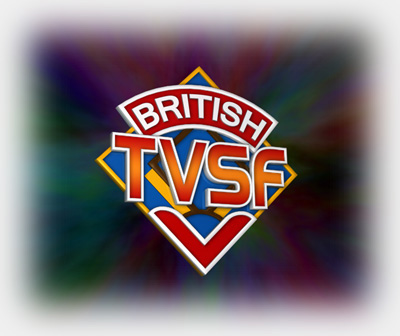
Say what you like about the wobbly sets, cheap video effects and inch-thick matte-lines that were frequently a staple of British SF TV shows, you've got to admit they sure knew how to design and build space-ships and robots and other cool stuff like that...
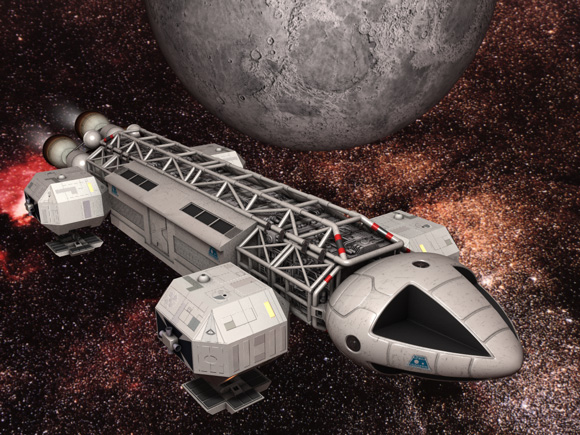
One of my all-time favourite spaceships from the best-looking TV show of the 1970s... A tricky one to build, but worth the effort. I was almost finished this when I discovered that there's lots of 3D Eagle models available for download on a number of Space 1999 websites, and a couple of them are way more accurate than mine. Grr! Still, never mind - the point was not to have a model of the Eagle, but to build one.
Rendering modes... Now, for those who aren't familiar with CGI, I should explain that it's not as simple as constructing a model and then clicking the "Render" button... There are all sorts of different ways a scene can be rendered. For example, here's a close-up of the Eagle using the bog-standard settings:
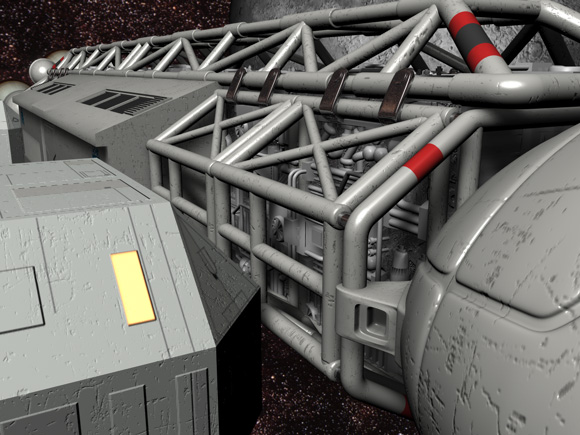
Now, the same angle again, but this time using Global Illumination (GI). This is a process where light is effectively bounced around the scene to create a more realistic lighting: since the parts of the Eagle are very light in colour, they each reflect a small amount of light onto their surroundings.
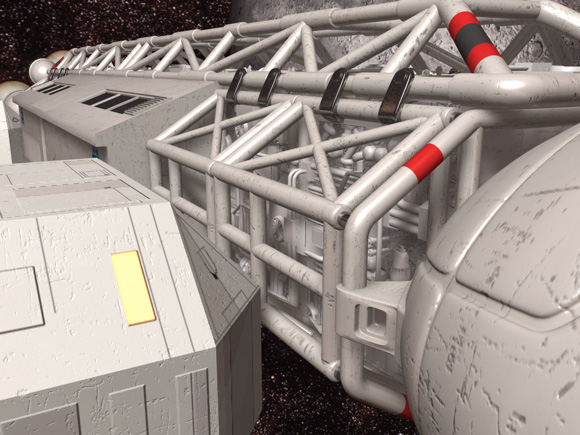
Now in addition to GI, we have Ambient Occlusion (AO). In some ways this can be considered to be the reverse of GI: shadows are cast in the narrow edges where the light just can't quite reach them (this explanation is, of course, a vast oversimplification of the process!).
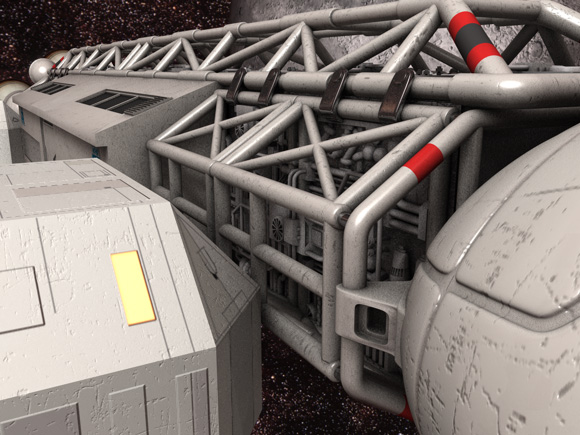
All this extra realism comes at a price... Here's a slice-comparison, complete with the times it takes to render the images on my quad-core PC.

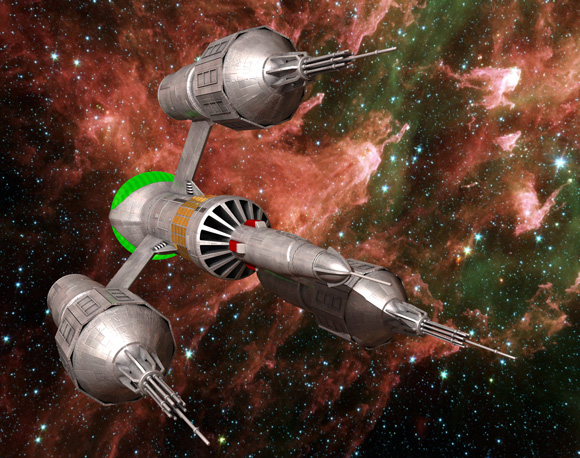
All together now... Dan-da-daaaaan, dan-dan-DAN-da-daaaaan...
Yes, it's the Liberator from everyone's favourite apostrophe-optional TV show, Blake's 7 (or, if you prefer and don't mind being wrong, Blakes 7).
The hull of the real Liberator looks more like a matt white rather than shiny metallic, but that didn't look cool enough on my model. This was a very simple build compared to the Space: 1999 Eagle, mostly because there's so much symmetry and repetition in the design.
I'm not sure how accurate this is: there are very few really good images of the Liberator on-line, and almost no blueprints (unlike the Eagle, which is featured in bazillions of websites), so this is more of a best-guess interpretation. Put any inaccuracies down to "artistic licence" and "not really caring all that much."
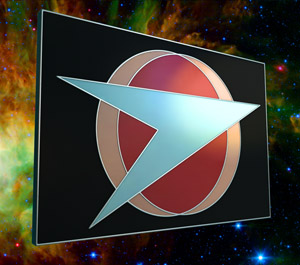 Also from Blake's 7, if you're more inclined to side with the baddies: the Federation
Badge.
Also from Blake's 7, if you're more inclined to side with the baddies: the Federation
Badge.
Commissioned - like the Judge Dredd Badge and Belt Buckle - by Wakefield Carter of Termight Replicas, this is an officially licensed item, 3x4.5cm, silver-plated metal with four-colour enamel...
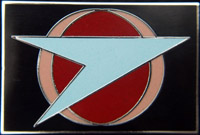
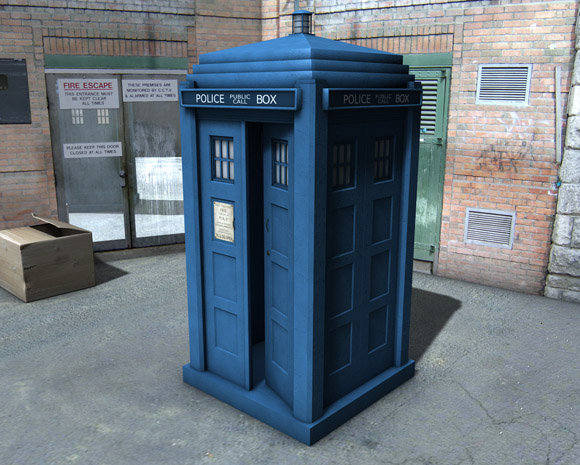
Possibly the most iconic image in science fiction, and it's not even a space-ship... It's a phone-box for police officers.
I ran a quick search on the web to find some good reference images for the Tardis, and discovered that even though the machine's camouflage circuits are allegedly broken, there's been a heck of a lot of different designs over the years. OK, so they all adhere to the same basic shape, but many of the features (such as the light on top, the "Police Box" sign, the windows and even the colour) seem to be rarely the same from one Doctor to the next.
Starbug was the first model I attempted to create on a PC (though not the first ever: that was the USS Enterprise on my ZX Spectrum using Vu-3d - a less-than-successful effort), and the only 3D software I had was POV-Ray. This was back in April 1994, before POV-Ray had all sorts of fancy graphical user-interfaces available. To create a model you supplied POV-Ray with a text file that described the scene, like this:
object { // enginesph1
sphere {<0,0,0>,1}
texture { hullgif }
scale <0.250000, 0.250000, 0.250000>
translate <-1.200000, -0.400000, 0.800000>
}
Lots more along those lines, and you get one of these:
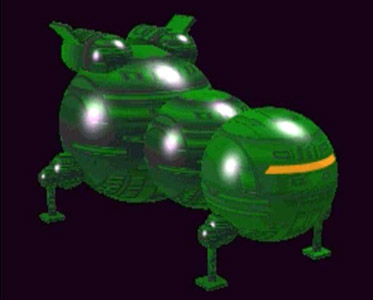
I guess it's not too terrible, considering that I was effectively working in the dark. But it's not too good either.
Thankfully, technology has moved on a lot, I've learned a little more about modelling, and now, sixteen years later, I'm finally approaching something that looks like Starbug...
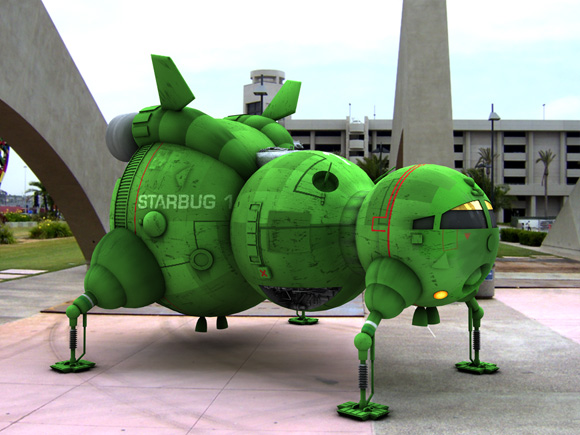
Just like with the Tardis, the "official" design for Starbug depends on which series of Red Dwarf you're using as a reference. But unlike the Tardis - and just like the Liberator - there's not many really good pics of Starbug on the web, so my model here is a hodge-podge combo of best-guesses and favourite-part-picking.




